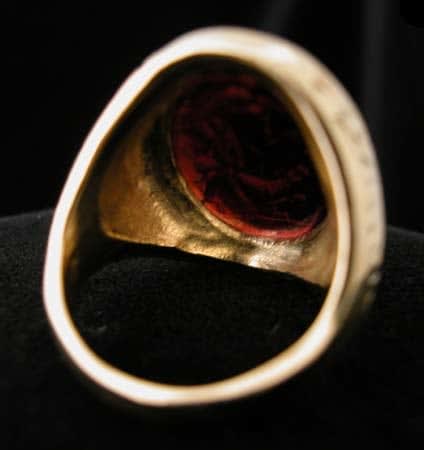Gold Ring with Classical Revival Garnet Intaglio of a Man Feeding a Dog, 18th Century CE
Garnet and Gold
FJ.6622
Further images
The art of glyptics, or carving on colored precious stones, is probably one of the oldest known to humanity. Intaglios, gems with an incised design, were made as early as...
The art of glyptics, or carving on colored precious stones, is probably one of the oldest known to humanity. Intaglios, gems with an incised design, were made as early as the fourth and third millennia B.C. in Mesopotamia and the Aegean Islands. They exhibit a virtuosity of execution that suggests an old and stable tradition rooted in the earliest centuries. The tools required for carving gems were simple: a wheel with a belt-drive and a set of drills. A special difficulty of engraving intaglios, aside from their miniature size, was that the master had to work with a mirror-image in mind.
The Classical Revival was a phenomenon that swept through Europe in the 18th and 19th Centuries. A new appreciation for antiquity and ancient art forms was fostered by discoveries in the nascent scientific field of archaeology. Perhaps the Classical Revival also reveals a latent longing towards the Arcadian lifestyles of yesterday abandoned as Europe became rapidly industrialized and increasingly urbanized. Engraved upon the polished surface of this precious gemstone is a scene of a naked man bending forward to feed his trusty canine companion who heels at his side. Might this be a scene from a myth? Surely this simple yet rewarding act can be easily identified with. Throughout the ages, dogs have faithfully stood by humans, our finest animal companions, from the Roman Era, to the Victorian Age, to today. Set inside the lovely gold ring with an engraved decorative pattern, this intaglio seal is a fitting memorial to the Classics it honors.
The Classical Revival was a phenomenon that swept through Europe in the 18th and 19th Centuries. A new appreciation for antiquity and ancient art forms was fostered by discoveries in the nascent scientific field of archaeology. Perhaps the Classical Revival also reveals a latent longing towards the Arcadian lifestyles of yesterday abandoned as Europe became rapidly industrialized and increasingly urbanized. Engraved upon the polished surface of this precious gemstone is a scene of a naked man bending forward to feed his trusty canine companion who heels at his side. Might this be a scene from a myth? Surely this simple yet rewarding act can be easily identified with. Throughout the ages, dogs have faithfully stood by humans, our finest animal companions, from the Roman Era, to the Victorian Age, to today. Set inside the lovely gold ring with an engraved decorative pattern, this intaglio seal is a fitting memorial to the Classics it honors.







